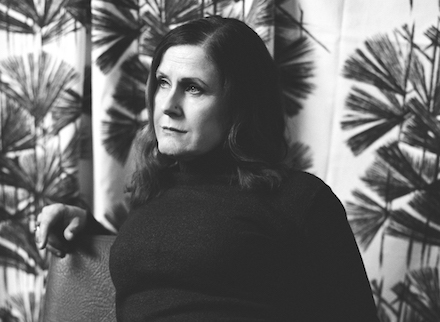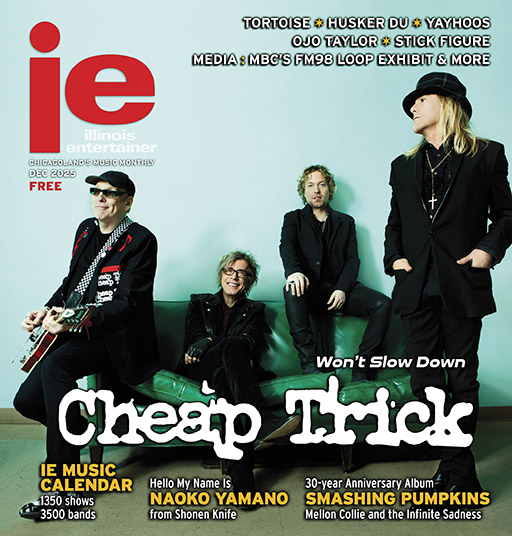Cover Story: Alison Moyet • Legacy is Overrated
She may not have descended to the cynical, humanity-doubting depths of Moliere’s “The Misanthrope.” But synth-pop diva turned Neo-soul stylist Alison Moyet could be getting awfully close.
The French-descended, English-bred artist first conquered worldwide charts via Yazoo (or just Yaz Stateside), her memorable duo with ex-Depeche Mode keyboardist Vince Clarke, and its definitive 1982 smash hit “Only You” — a bubbly anthem so definitive of the New Wave era that it’s still finding film and TV soundtrack usage, most recently in a childhood flashback scene in HBO’s fall miniseries The Penguin. Then she stepped out on her own in 1984 with Alf, powered by no less than four hit singles — “Invisible,” “Love Resurrection,” “All Cried Out,” and “For You Only” — then followed it with nine successive solo sets, most recently Other in 2017. And now, at a well-seasoned 63, she’s celebrating four decades of said post-Yaz career with Key, a compilation of 16 deep-catalog cuts reimagined for her current electronica-sculpted concert schematic (wherein “Love Resurrection” and “All Cried Out,” for instance, strip back to revival-meeting Gospel roots), plus two new tracks — a synthesizer-thrumming “The Impervious Me” and the thoughtful processional “Such Small Ale.” But in many ways, it’s still pre-cellphone, pre-internet 1984 for Moyet, who still isn’t sure that all of our ensuing technological, post-MTV advances are a good thing.
Getting your news from strictly online sources? The Brighton-based chanteuse harrumphs disdainfully. “It’s a scary thing, isn’t it? And you can see it yourself on social media, even just in things written about you,” she offers. “Somebody could write something about you, and you’ll think, ‘Well, that’s just not true!’ But it then becomes a fact because people are repeating it. And you think, ‘Jesus! That’s a really scary place to be!’ Because it then becomes so partisan, with a lack of nuance, a lack of tolerance for different ideas, or the basic concept of Live and let live.” She sighs ominously. “So now it’s all so black and white, and it’s certainly not what I grew up to expect.”
Moyet dropped out of high school at age 16 to join Clarke for two classy Yaz albums, Upstairs at Eric’s and You and Me Both. But she never fell into the technological slipstream and only recently learned how to operate home-studio computer program musts like Logic (more on that later). “And I am of that generation that can’t type,” she adds, noting the gradual demise of once-necessary cursive writing. “I still have to type everything with just two fingers, you know? And it takes me AGES. And then you try and write again, but then you have to try and read your own handwriting, and it’s like, ‘What on Earth was I saying?’” And GPS travel-charting devices? All well and good, she supposes. “But I still recall every year as a kid, when we would go to France to see my relatives, and my dad sitting down with his big map and planning the route. But now you come across people who don’t even know how to read a map, and you think, ‘Whoa! What if it all goes down? People are so fucked for some basic skills!’ Basic life skills, you know?” And don’t even get her started on looming advances in Artificial Intelligence. “Because that’s the really scary thing,” she says. “All of these AI photographs, where they can just mock up all of these complete untruths, just put people in…in…well, it’s just like ‘Alice Through the Looking Glass,’ isn’t it?”
Indeed, it is. So what’s a retro-minded composer to do but remain pretty grounded in reality? Returning to Brighton a few years to act as caregiver to her dying parents helped in that department, as did returning to art college, first to study sculpting, then — during pandemic lockdown — Fine Art Printmaking, for which she just earned a first-class BA degree. Ergo, at home these days, she is constantly busy making unique pieces of art, employing many diverse mediums, and simply appreciating the various forms of art itself, as exemplified by “Key” cover and press photos, which feature Moyet in Spartanly-appointed rooms with various paintings, photographs, sculptures, even antique furniture that she finds appealing. She took a similar tack when selecting cuts worth reworking for “Key,”lesser-known numbers like “Where Hides Sleep,” “My Best Day,” “World Without End,” and “Is This Love” from **Raindancing.” And if the art proves significant to her forty years on, it should surely mean something to other fellow aesthetes, she reasoned. But there is one genre that’s been somewhat difficult for her to appreciate, she admits: Film.
“And I love films,” Moyet enthuses. But she has a quirky difficulty with facial recognition that sometimes erases her memory of movie characters as soon as she leaves a theater, she says. “And this has happened all my life — it’s not an age thing. Even if there are lots of people with the same hair color in the film — that really, really throws me off because I can’t remember one from the next. And honestly, it’s just terrible, this face-blindness. And I really like talking to people, I really like being with people, but I remember this one interview I did, where we had a really good conversation. We were talking for about a half hour.” But then she paused for a bathroom break, she says, “and I then came back and introduced myself to him! And (the condition) is awful because people think you’re shallow, you know? That you’ve got no depth. But it’s just that I can’t recognize faces, and it’s been a real bane of my life in this job, which is so much about networking and stuff.”
Thankfully, her chat with the IE was limited to Zoom Audio, which led to all the revelations below….
IE: So you launched your own podcast this year, “40 Moyet Moments”? But how do you pick 40 important moments?
ALISON MOYET: Well, I think we were just thinking about ways to just talk to the fan base, or talk to people that were kind of interested in the trajectory. And Steve Coates-Dennis, who’s my digital manager and he’s a fan of old, he had this idea that we could break up the 40 years into these moments and have a platform that was both brief little sessions but at the same time allowed me to use my own language, my own voice. And the case is that you’re dealing with the same questions all the time, and you’re not given time to hang yourself, you know, so you end up talking in sound bytes. So this was an idea of how we could talk about those events but allow ourselves to go with it if we felt like there was something to expand on or not if we didn’t.
IE: What’s the most unlikely moment you ended up selecting? Like, ‘The day I bought an iguana’?
AM: Ha! No, I think, obviously, they’re all career-based. Steve had chosen the questions, so I didn’t go into it thinking I could really try and control it. I wanted it to be fluid, and the reason it was good doing it with him was because he’s someone that knows me, and he’s good at remembering events that I’ve forgotten, so he’s good for triggering me to remind me of certain things. But what really worked about it is, because we’re mates, I kind of forgot that I was being interviewed, so there wasn’t any careful footing — it was just an honest conversation.
IE: Were there any of your own answers that surprised you? Or things you’d totally forgotten?
AM: Oh yeah! Loads of things! Because I really have a difficult time remembering events, and I’ve always been that way — it’s not just an age thing. It’s like I don’t carry those memories with me. It’s like I’ve got some sort of…deficiency in that department because I can go to certain places, and someone will say. To me, “When was the last time you were here?” And it’s like, “Have I been here?” I don’t even know that I’ve been there. I forget faces. I forget names. But I remember feelings.
IE: What was the most surprising story from your past that you rediscovered?
AM: umm…do you know what? I’m never surprised. That’s not really a facet of my character because I am well-lived in, so surprise, disappointment, those kinds of things? They don’t even occur to me, so I’m not surprised by anything. I deal with the minute, so every minute that happens feels fresh and relevant to me, and because I don’t carry those things on, I don’t live anywhere but the minute.
IE: Did the podcast give birth to the idea for Key?
AM: No. Key was made. Before we did the podcast. And for me, the whole point of Key was, first of all, music was really affected by the lockdown and all that kind of stuff, so when all of that happened, I decided to go to university. And I’d left school at 16, I didn’t have any qualifications at all, I didn’t graduate high school or anything. So that was something I kind of thought I’d do all the way through my life, thinking my career as a singer was going to end by the next year. But it kind of never happened. So when I got to, just before I was 60 and lockdown happened, it seemed like a good time to do it. But for me, live music is where it’s at — it’s my favorite place, and so I wanted to sing live. And one of the problems that you have when you’re a solo singer, and you’ve had a career of some 40 years, and you’ve worked with lots of different musicians and lots of different producers is, you end up with a really schismatic catalog. And when you try to take that to a live forum, if you were to treat all of that material in the way that it was dealt with when it was first written, you end up with some really nasty karaoke. So I’d come to a place where I’d been working with electronica live — it’s what I wanted to do — so it was about going back and looking at my catalog. I was in university, so I didn’t have time to start writing. So I came out, and I know that I’m running out of time, just in terms of being a singer, and I can expect the voice to go at any time, so I wanted to play live. And so, finishing university tied in with this 40th anniversary, and promoters, they like you to have a record out when you go on tour. So it all made sense to me to look at the material that I’d done, find a way that I could bring songs together into a cohesive set, but also look at the material and find the stuff that could still resonate with me as an artist in my 60s.
IE: And you said you didn’t just want a “Hits” package…
AM: Nom, I never want a “Hits” package. I never want to do that, and I’ve turned down lots of lucrative nostalgia tours because they’re of no interest to me. Like I said, I don’t live in the past, so the idea of having three years of my life that turn into “Groundhog Day” is just appalling to me — I don’t want to spend my life doing that to earn money. But I am an artist, and I am a live artist, and I want to work live. But it’s really important for me to genuinely engage with everything I do onstage — I don’t just turn it in; I won’t just dial it in. And I won’t do a song if I’m not feeling it, which in some ways could be a problem for me in America because I have one song that troubled the charts there, but I haven’t sung that song in 35 years because it doesn’t resonate with me. And you know, that can confuse people. But I like to be straightforward about that because I don’t want anyone to spend their money and feel cheated.
IE: We’ve talked so many times over the years, and I just stumbled upon one recent interview we did where you were studying sculpting. But your university degree is in printmaking?
AM: No — I’d done that before. I’d done sculpting when I was doing…I think it was the other album. But No — I did Fine Art Printmaking. And it’s funny for me because I come from quite a long line of lithographic printmakers, and when I left school at 16, that was one of the things that I wanted to do. I’d grown up around these inks, and my dad had worked in the Kirwan Studios with some really impressive artists as a lithographic fine art printer. And Kirwan was quite a famous art house, and he worked a machine — he was the lithographer.
We lived in a little council house with very small walls, so I’d grown up with some really fine prints on the wall that really dominated the room. So I’d grown up with the smell of that and that kind of paper, and I really liked the idea of doing that as a job. I knew that I was interested in doing some manual work, but my dad – a very patriarchal Frenchman — was like, “No! Closed shop! No women!” No women — it was a closed union, and they didn’t accept women at the time, so that sat with me, as you can imagine, there was always this desire. And so when lockdown happened, and I’d done a foundation course in art, I thought that’s what I wanted to do. They had a great printing course in the town that I live in, in Brighton, at Brighton University, so I signed up and did that. And I got completely mesmerized, and so when that happens, I don’t do anything else —I deep-dive into it. But when I came out, I wanted to sing live; I wanted to go on tour. I’d almost gone on tour between my second and third year when I signed up to be the special guest with Tears For Fears on one of their tours. But that tour got canceled because Curt had broken his ribs, and so we did this one gig at the end of it, and it just reminded me — on my own, we did it, with just one day for selling it, and we did it in Brighton, and it reminded just how much I wanted to sing live again.
So, the purpose of Key was to look at the catalog for over 40 years and to bring in songs that still spoke to me. Or songs that I felt hadn’t quite been realized, or had an aesthetic that I didn’t like anymore, or were lost in the waves of my career. And I know that in America, for many people, it won’t be deemed a career, but certainly in the UK, I’ve had a constant level of success. And within that time, I felt that there were songs that I felt were really significant songs that were kind of lost or went unnoticed. So it was a way of me pulling together hits and bringing them into the sound that I work with live now, and also platforming these deep cuts or songs that had gone unnoticed, along with others that I liked but I wanted to readdress.
IE: Call me curious — many people do — but what was your final thesis in your Printmaking course?
AM: Well, ‘thesis’ is stretching it a bit — it was a long essay since it was a practical degree. But it was about cells that I was using that tied in with Louise Bourgeois. With Picasso’s muse, The Weeping Woman, Dora Maar. So it was talking about the cells that we impose on ourselves, the boundaries that we impose on ourselves, and other ones we put on other people. So it was talking about the cell that Dora Maar got put in by being forever framed as The Weeping Woman, as opposed to this fantastic artist that she was in her own right. So, she was then framed by a man instead of being in control of her own profile. And it wasn’t just the ‘male gaze’ thing —it was that her fame was seen in the context of her relationship with — and what she brought to — her relationship with Picasso, when she was a very innovative artist in her own right. And much of that is forgotten. So it’s not just The Spurned Lover. Shit happens. And we are more than the context of our couplings.
IE: Do you remember any amazing lithographs your family had on the walls when you were a kid?
AM: Oh yeah! Absolutely! I do, and I’ll have the same problem of not being able to name the artist for you. But I see the images completely, firmly — I see them, and there was one by a Welsh artist of two miners sitting together. That one I remember. We always had a DaVinci on the wall, and I remember my dad when he later went on to do work at the Kirwan Press because when he was at Kirwan Studios, he was a very talented lithographer, but unfortunately he was prone to bursts of anger, and he punched the manager out and got sacked on the spot. But then they sent him a letter the next day offering him another job because he was such a good worker — my dad never took a day sick. He was a really, really good worker — he was just a bit incorrigible, so he had to leave the one place, but then they put him straightaway somewhere else. So then when he went on to that, I remember him doing these….here we go again! Who was the American artist with the blonde hair who did Marilyn?
IE: Warhol?
AM: Warhol! Yeah! He did quite a few of those prints, and at one point, I’d wallpapered the whole of my bedroom with the Marilyn Monroe prints because there were so many of them. So it was like the whole bedroom was wallpapered in Warhol.
IE: Are the various art objects featured in all the Key album photos and press shots actually yours?
AM: Yeah. Yeah, the artwork’s all things that I’ve worked up. For example, what is the image on the back cover? That’s because when my parents were sick, they asked me what I would like to have of theirs to keep, and I chose the laundry bucket. And I wanted the laundry bucket because that had been my first baby bath, that had been my paddling pool, and then that was the bucket that I remember my mom putting the laundry in, so it was really significant to me. So I had this bucket at home, and I’d taken it out into the garden and filled it up with water, like I did when I was little, and then shot pictures of the surface of the water and took that into a printing where I developed it onto a zinc plate. And then when the plate was being exposed, I took a photograph of the plate being exposed and then distorted that, and then from that, I did lithographic prints, so that’s how that image at the back of that photograph that I’d cut out was developed behind it.
IE: Do the rules of lithography and the rules of songwriting overlap?
AM: Yes. What was quite good about doing lithography was that I could be someone who rushed ahead. I can rush ahead. And I’m always cutting corners, you know? And with printmaking, you cut corners, and you’re just going to produce print after print that’s damaged, where your borders are damaged — all these kinds of things which are really, really relevant, which forces you to just be meticulous. So what was good about doing lithography, which, when you’re doing photolithography, involves software? And with music, I’d always been really leery of technology, and I couldn’t sit long enough with it — I would get bored and distracted. So I always needed somebody for those kinds of technical aspects. But when you’re doing that at university, that’s a part of your course, so then I was forced to use certain software, and doing that took away the mystery of the language that happens with computer work. So interestingly, then I came out of university and got straight into working with Logic, which I’d avoided the whole of my career. So, in that sense, Yeah — I graduated at 60 and started using Logic at 60.
IE: I like how you approach all art in those photos — even random pieces of furniture appear equally significant to you.
AM: Yeah. And it’s the memory that furniture holds. For example, one of my final pieces in the exhibition was from a sewing box that had belonged to my great-grandmother that had been left to rot in my dad’s garage until all the fabric had deteriorated. So I took that out, and again, I’m very interested in grids and frames, and I’ve come to understand how important boundaries are to get me from A to B, and so I stripped out this box and printed fabric to reline it, and then did etchings that I set up in it. Then, I had a poem at the bottom of it, so I dealt a lot with memory and the corruption of memory. All of the things within that photograph are objects that have a strong significance to me. They’re all very significant objects, and that’s what I deal with. And with songwriting, because I’m so chaotic, a lot of it is about trying to bring all of these thoughts that I have together and putting ‘em down in one place, fixing them in one place so I can observe them so that they’re not constantly spinning out of view. And there’s that factor, as well, in my artwork. One of the things that I found so difficult about university is I am swamped with ideas, I am always swamped with ideas. But the only thing that ever stopped me was the technical ability to bring those things together. And one of the things that I found really frustrating about it was, a big part of it is you’re supposed to talk about what you’re influenced by.
And as you know, by this conversation that we’ve had, I don’t hold on to names. I’ll see things and be impacted by them, but I don’t carry their stories away — I imprint my own stories upon them. So I’ve been in this ridiculous position where I was having to then find other artists that made work similar to mine so that I could say that I was influenced by them. And the thing is, when you’re in your 60s, you have a life of reference points. You have a lived life of reference points. So I don’t need to find out how other people live. I don’t need to find out their ideas because I am drowning in my own and just wanting to find ways of putting them together. So, in that sense, my artwork and my writing — that’s how they converge. From this desire to pull myself in, pull myself in, and try to find my edges.
IE: Do you go shopping for obscure stuff? To flea markets, as they call them here?
AM: No, no. All of these things have just traveled with me. Like the chest, the chest of drawers. I picked that up from my girlfriend, and it was just her old bedroom furniture from when we were 17, and she’d probably bought it from a flea market. But I still have that, and now it’s in my living room. The vase there is something my godmother bought for my mom when she was pregnant with me, so everything has significance to me — there’s nothing of financial value. It’s just everything that came through from my childhood. But that’s the great thing about being older, just like with me going to university — I was with cohorts of 19 and 20 years old. I think that’s a really important message for them because we get sold this idea that we will become asinine and no longer want to engage, so it’s got to be a good message for anybody that you can still be interested. You can still be interested, and also that there’s so much more to life than acquisition, you know?
IE: Have you found yourself cutting material ties? Just letting go of a bunch of stuff?
AM: Listen — I did that years ago. When I moved to Brighton, where I live now, I had the big house, the dream that you have when you’re a working-class kid, this kind of big house. But actually, with the environment that we lived in, we didn’t make friends, we were isolated, and we thought, “Fuck it! We’re gonna sell up, and we’re gonna go and live on a regular street, in a town, we’re gonna downsize, and we’re gonna be a part of the community. And I trashed just about everything I had. I trashed all my gold discs, I trashed all of my memorabilia, I got rid of everything — I just got rid of most of my belongings. And I suppose it’s another thing, but I look at my parents and the things that they kept so carefully, that they looked after and you weren’t allowed to touch. And then there you were at this point in your life where you were having to pick and choose between things in their life, and there was this awful feeling when you know how carefully they’d kept a pan. And you then got to choose what went in the bin and what got saved, and there was a part of me that thought, “I don’t want to put that on my kids. I don’t want them to have that stuff because their futures shouldn’t be about some mausoleum mother — it’s about them, and it’s about their children. And yeah, it’s nice that I did stuff, but is it just the idea that you have to forever be scented in your family’s life? It just feels like a load too much to put on someone. So if I trash my own stuff and get rid of everything, you don’t have to carry my luggage. So that felt like a kind thing to do.
IE: Are you a collector of anything at this point?
AM: No. No. It’s like my husband says of me, that I’m the least materialistic person that he knows. So I have a few things. I’ve got pictures that my kids made when they were at school, and like I say, I’ve got my mom’s laundry basket. I have little things like that, but those little things? You’re just aware that when you’re not there anymore, no one else is gonna know the significance. And you know, I think that’s alright. I think Legacy is overrated.
-Tom Lanham
Appears May 7 at The Vic Theatre, Chicago
Category: Cover Story, Featured












